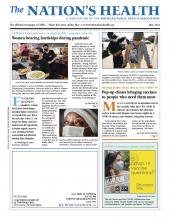
MAX Light Rail is a public transportation service in Multnomah County, Oregon.
By Mtruong596, via Flickr Creative Commons
Last summer, violence toward people protesting against racism and police violence in Portland, Oregon, brought national attention to a city that has long struggled with racial disparities. A recent report by the Multnomah County Health Department finds the region’s equity challenges extend into the county’s transportation infrastructure, but that there is opportunity for change.
From 2013 through 2017, death rates from crash injuries among Black residents in the county were nearly twice as high as those of white residents, according to “Multnomah County REACH Transportation Crash and Safety Report: At the Intersection of Transportation, Health, Race and Justice,” which was released Feb. 25.
Data from emergency department and urgent care visits showed that Black residents, while accounting for 8% of the county population, represented 17% of patients who were in traffic crashes. The highest number of crashes were in Black communities. A study from Portland State University also showed that Black pedestrians at open crosswalks wait 32% longer for drivers to give them the right of way than whites do, the report shared.
A combination of individual racism, systemic racism and failure to fund infrastructure in Black communities — funding that could lead to safer roads and crosswalks, efficient public transportation, and more bike and pedestrian paths — exacerbate health inequality in the county, according to the report.
Racism and poor infrastructure also impact physical activity, according to Andrea Hamberg, Multnomah County’s interim environmental health services director and co-author of the report.
“Most of the leading causes of premature death in Multnomah County can be treated or prevented through physical activity, and there are racial disparities for most of those conditions,” Hamberg said. “But we can’t ask people to be active in spaces that are threatening. The report recognizes that we can’t make progress on public health goals without safe places to get regular exercise, engage community and access basic needs.”
To address the gap in transportation equity in the county, the report shares policy, system and environmental strategies that can drive sustainable change.
The report was produced through the Multnomah County Health Department’s Racial and Ethnic Approaches to Community Health program. REACH, which stands for Racial and Ethnic Approaches to Community Health, is a 20-year Centers for Disease Control and Prevention initiative that works to reduce racial and ethnic health disparities in communities across the U.S.
In Multnomah County — which comprises much of Portland — the local REACH program collaborates with a coalition dedicated to improving health equity in urban Black communities by improving social determinants of health.
To read the report, visit www.multco.us/reach.
- Copyright The Nation’s Health, American Public Health Association









